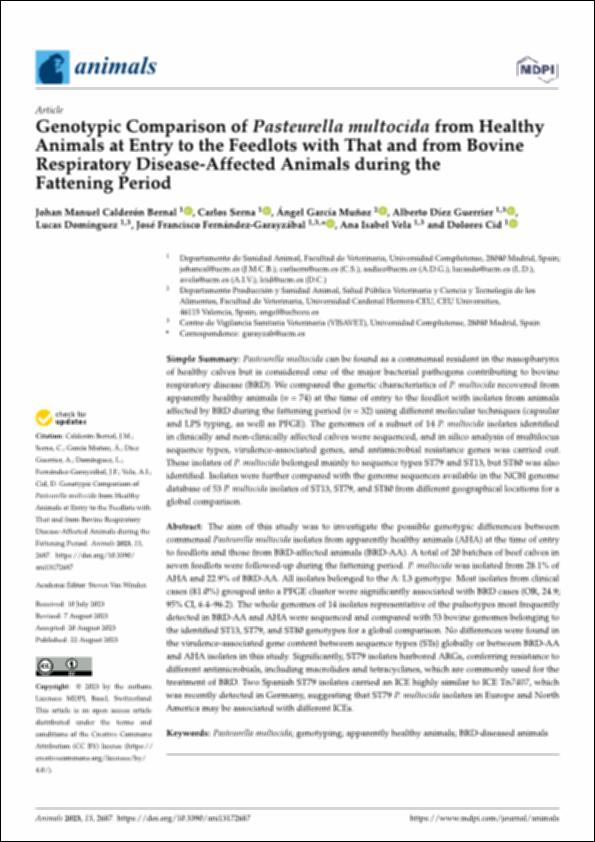Por favor, use este identificador para citar o enlazar este ítem:
http://hdl.handle.net/10637/16037Genotypic comparison of "Pasteurella multocida" from healthy animals at entry to the feedlots with that and from bovine respiratory disease-affected animals during the fattening period
| Título : | Genotypic comparison of "Pasteurella multocida" from healthy animals at entry to the feedlots with that and from bovine respiratory disease-affected animals during the fattening period |
| Autor : | Calderón Bernal, Johan Manuel Serna, Carlos García Muñoz, Ángel Díez Guerrier, Alberto Domínguez, Lucas Fernández Garayzábal, José Francisco Vela, Ana Isabel Cid, Dolores |
| Materias: | Ganado vacuno; Cattle; Aparato respiratorio; Respiratory systems; Enfermedad animal; Animal diseases |
| Editorial : | MDPI |
| Citación : | Calderón Bernal, J.M., Serna, C., García Muñoz, Á., Díez Guerrier, A., Domínguez, L., Fernández-Garayzábal, J.F., Vela, A.I. & Cid, D. (2023). Genotypic comparison of "Pasteurella multocida" from healthy animals at entry to the feedlots with that and from bovine respiratory disease-affected animals during the fattening period. Animals, vol. 13, art. 2687 (22 aug.). DOI: https://doi.org/10.3390/ani13172687 |
| Resumen : | The aim of this study was to investigate the possible genotypic differences between commensal "Pasteurella multocida" isolates from apparently healthy animals (AHA) at the time of entry to feedlots and those from BRD-affected animals (BRD-AA). A total of 20 batches of beef calves in seven feedlots were followed-up during the fattening period. P. multocida was isolated from 28.1% of AHA and 22.9% of BRD-AA. All isolates belonged to the A: L3 genotype. Most isolates from clinical cases (81.0%) grouped into a PFGE cluster were significantly associated with BRD cases (OR, 24.9; 95% CI, 6.4–96.2). The whole genomes of 14 isolates representative of the pulsotypes most frequently detected in BRD-AA and AHA were sequenced and compared with 53 bovine genomes belonging to the identified ST13, ST79, and ST80 genotypes for a global comparison. No differences were found in the virulence-associated gene content between sequence types (STs) globally or between BRD-AA and AHA isolates in this study. Significantly, ST79 isolates harbored ARGs, conferring resistance to different antimicrobials, including macrolides and tetracyclines, which are commonly used for the treatment of BRD. Two Spanish ST79 isolates carried an ICE highly similar to ICE Tn7407, which was recently detected in Germany, suggesting that ST79 P. multocida isolates in Europe and North America may be associated with different ICEs. |
| Descripción : | Este artículo pertenece a la colección " Cattle Diseases". |
| URI : | http://hdl.handle.net/10637/16037 |
| Derechos: | http://creativecommons.org/licenses/by/4.0/deed.es Open Access |
| ISSN : | 2076-2615 (Electrónico) |
| Fecha de publicación : | 22-ago-2023 |
| Centro : | Universidad Cardenal Herrera-CEU |
| Aparece en las colecciones: | Dpto. Producción y Sanidad Animal, Salud Pública Veterinaria y Ciencia y Tecnología de los Alimentos |
Los ítems de DSpace están protegidos por copyright, con todos los derechos reservados, a menos que se indique lo contrario.


